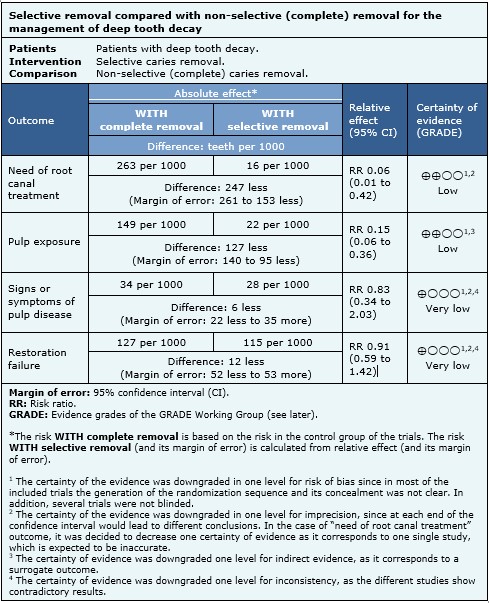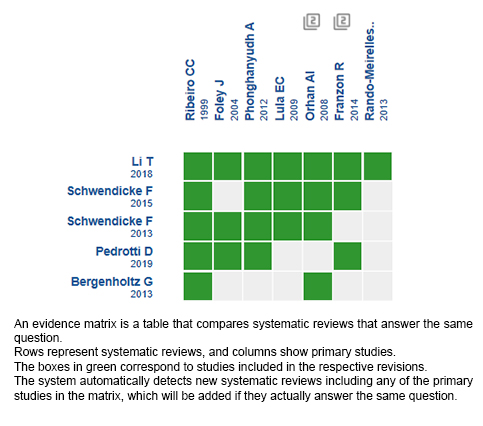Epistemonikos summaries
← vista completaPublished on January 28, 2020 | http://doi.org/10.5867/medwave.2020.01.7758
Selective removal compared to complete removal for deep carious lesions
Remoción selectiva comparado con remoción total para caries dentinarias profundas
Abstract
INTRODUCTION Dental caries have been conventionally managed by non-selective removal of carious tissue (total complete removal); however, the adverse effects of this procedure have promoted the use of conservative caries removal techniques (selective removal), but there is still controversy regarding its effectiveness.
METHODS We searched in Epistemonikos, the largest database of systematic reviews in health, which is maintained by screening multiple information sources, including MEDLINE, EMBASE, Cochrane, among others. We extracted data from the systematic reviews, reanalyzed data of primary studies, conducted a meta-analysis and generated a summary of findings table using the GRADE approach.
RESULTS AND CONCLUSIONS We identified seven systematic reviews including seven studies overall, of which all were randomized trials. We concluded that selective caries removal may decrease the need for root canal treatment and the risk of pulp exposure in teeth with deep caries, but the certainty of the evidence is low. It is not clear whether the selective removal of caries reduces the risk of appearance of signs and symptoms of pulp disease and the risk of restorations failure, as the certainty of the evidence is very low.
Problem
Dental caries is the most prevalent dental disease worldwide[1]. Traditionally, its treatment involves non-selective (complete) removal of carious and demineralized tissue, and subsequent restoration of the dental piecetooth[2]. However, this dental preparation technique has been questioned in recent years for the associated adverse effects, such as pulp exposure and development of pulp disease[2],[3].
Consequently, conservative techniques have emerged as an alternative for the treatment of deep caries. One of them consists of the selective removal of carious tissue, in order to preserve as much dental structure as possible and so avoiding adverse effects[4]. This technique has been defined in various ways in the literature, with discrepancies in excavation depth and clinical removal criteria. The most accepted definition is the one proposed by the International Caries Consensus Collaboration (ICCC), which defines selective removal as the excavation technique in which peripheral dentin is removed until only hard dentin is left, while the pulp wall is excavated until reaching firm or soft dentine[5].
However, it has been suggested that this technique would lead to restoration failures, so its use remains controversial[6]. This summary aims to evaluate the effectiveness and safety of selective caries removal compared to complete removal.
Methods
We searched in Epistemonikos, the largest database of systematic reviews in health, which is maintained by screening multiple information sources, including MEDLINE, EMBASE, Cochrane, among others, to identify systematic reviews and their included primary studies. We extracted data from the identified reviews and reanalyzed data from primary studies included in those reviews. With this information, we generated a structured summary denominated FRISBEE (Friendly Summary of Body of Evidence using Epistemonikos) using a pre-established format, which includes key messages, a summary of the body of evidence (presented as an evidence matrix in Epistemonikos), meta-analysis of the total of studies when it is possible, a summary of findings table following the GRADE approach and a table of other considerations for decision-making.
|
Key messages
|
About the body of evidence for this question
|
What is the evidence See evidence matrix in Epistemonikos later |
We found seven systematic reviews[4],[7],[8],[9],[10],[11],[12] which included seven primary studies overall, reported in nine references[13],[14],[15],[16],[17],[18],[19],[20],[21], all of which correspond to randomized trials. |
|
What types of patients were included* |
Of the seven trials, five included only children (3 to 11 years old)[13],[14],[15],[18],[20] and two included children and adolescents (4 to 17 years old) [17],[19]. Four included only temporary teeth[13],[14],[17],[19], one trial included only permanent teeth[19], and two both dentitions[13],[17]. Regarding the extent of caries, all trials included only deep tooth decay, excluding those lesions circumscribed only to enamel. Five trials included occlusal and proximal caries[13],[14],[17],[18],[20], while two included only occlusal caries[15],[19]. Finally, all trials excluded patients with irreversible pulp symptoms and/or apical lesion prior to inclusion[13],[14],[15],[17],[18],[19],[20]. |
|
What types of interventions were included* |
All trials compared the selective removal of deep dental caries against conventional treatment (complete removal). Selective removal was described in various ways by the different trials, but in general it was defined as the excavation of the remaining dentin from the floor of the cavity near the pulp, soft to the touch, of sticky consistency and soft to the probing procedure[8]. None of the reviews included information on the instruments used or the depth of excavation. |
|
What types of outcomes were measured |
The trials measured multiple outcomes, which were pooled by the systematic reviews as follows:
The follow-up ranged between 6[15],[17],[18],[20] and 24 months[13],[14],[19]. |
* Information about primary studies is not extracted directly from primary studies but from identified systematic reviews, unless otherwise stated.
Summary of findings
The information on the effects of selective caries removal is based on seven randomized trials that included 570 patients.
Regarding safety-related outcomes, only one trial reported the events needing root canal treatment (48 patients, 120 teeth)[14], four trials reported the events of pulp exposure (477 patients, 489 teeth) [14],[15],[17],[18] and six analyzed the signs or symptoms of pulp disease (526 patients, 555 teeth)[14],[15],[17],[18],[19],[20]. With regard to effectiveness, all trials evaluated the events of restoration failure (570 patients, 641 teeth)[13],[14],[15],[17],[18],[19],[20].
The summary of findings is as follows:
-
Selective caries removal may decrease the need for root canal treatment in teeth with deep caries (low certainty of the evidence).
-
Selective caries removal may decrease the risk of pulp exposure in teeth with deep caries (low certainty of the evidence).
-
We are uncertain whether selective caries removal decreases the risk of the appearance of signs and symptoms of pulp disease as the certainty of the evidence has been assessed as very low.
-
We are uncertain whether selective caries removal decreases the risk of restoration failure as the certainty of the evidence has been assessed as very low.

|
Follow the link to access the interactive version of this table (Interactive Summary of Findings – iSoF) |

Other considerations for decision-making
|
To whom this evidence does and does not apply |
|
|
About the outcomes included in this summary |
|
|
Balance between benefits and risks, and certainty of the evidence |
|
|
Resource considerations |
|
|
What would patients and their doctors think about this intervention |
|
|
Differences between this summary and others sources |
|
|
Could this evidence change in the future? |
|
How we conducted this summary
Using automated and collaborative means, we compiled all the relevant evidence for the question of interest and we present it as a matrix of evidence.

Follow the link to access the interactive version: Selective removal versus complete removal of deep caries lesions
Notes
The upper portion of the matrix of evidence will display a warning of “new evidence” if new systematic reviews are published after the publication of this summary. Even though the project considers the periodical update of these summaries, users are invited to comment in Medwave or to contact the authors through email if they find new evidence and the summary should be updated earlier.
After creating an account in Epistemonikos, users will be able to save the matrixes and to receive automated notifications any time new evidence potentially relevant for the question appears.
This article is part of the Epistemonikos Evidence Synthesis project. It is elaborated with a pre-established methodology, following rigorous methodological standards and internal peer review process. Each of these articles corresponds to a summary, denominated FRISBEE (Friendly Summary of Body of Evidence using Epistemonikos), whose main objective is to synthesize the body of evidence for a specific question, with a friendly format to clinical professionals. Its main resources are based on the evidence matrix of Epistemonikos and analysis of results using GRADE methodology. Further details of the methods for developing this FRISBEE are described here (http://dx.doi.org/10.5867/medwave.2014.06.5997)
Epistemonikos foundation is a non-for-profit organization aiming to bring information closer to health decision-makers with technology. Its main development is Epistemonikos database (www.epistemonikos.org).
Potential conflicts of interest
The authors do not have relevant interests to declare.

